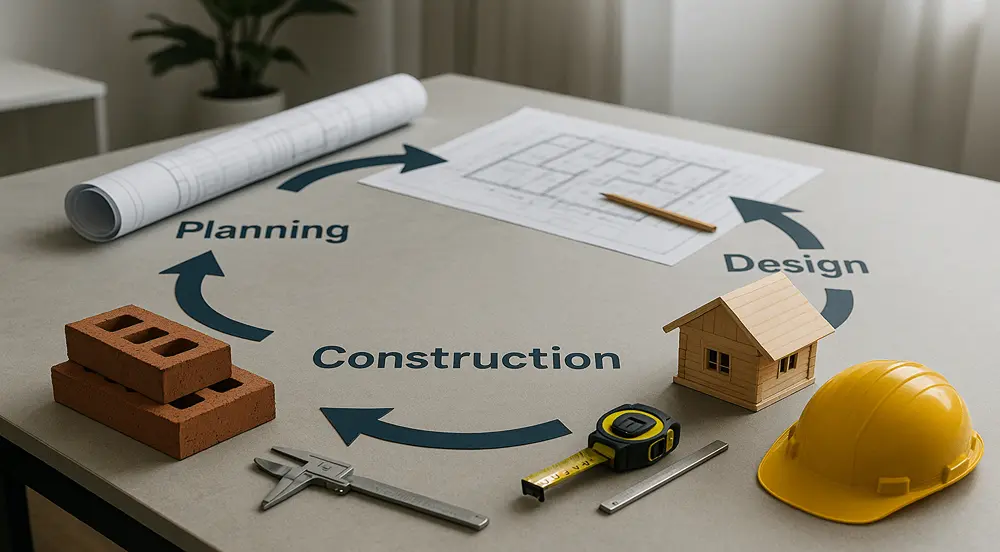Initiation, planning, execution, monitoring, and closure define the construction project life cycle, ensuring structured progress from concept to completion. This framework enhances coordination, quality, and resource control. According to PMI Australia, projects following defined life cycle phases achieve nearly 30% higher efficiency and success rates industry-wide.
Initiation Phase and Project Charter Development
Projects kick off by evaluating viability and gathering essential insights, turning vague ideas into concrete plans. Feasibility studies pinpoint economic and environmental factors, while identifying stakeholders and initial risks builds a robust foundation. For instance, Australian bridge projects often rely on thorough charters to secure government funding and avoid early pitfalls.
Defining clear purpose and objectives early fosters accountability among teams, minimising future disputes. A well-crafted charter outlines authority levels and success criteria, streamlining decision-making. Projects with solid charters cut scope changes by 35%, enhancing overall efficiency in complex builds.
Defining Scope, Objectives, and Stakeholder Expectations
Clear boundaries and measurable goals unite everyone involved, slashing unexpected revisions that inflate costs. In construction project management, this step involves mapping out deliverables and expectations to prevent misalignment. It transforms ambitious visions into achievable targets, fostering smoother collaborations from the outset.
- Kick-off meetings
- Stakeholder analysis matrix
- Scope definition statement
Planning Phase and Baseline Creation
Detailed blueprints emerge here, weaving together timelines, budgets, and resources for seamless progression. Scheduling tools like Gantt charts break down tasks, while work breakdown structures organise activities logically. This phase anticipates challenges, ensuring every element supports the construction project life cycle’s momentum.
Establishing baselines for cost, time, and quality forms the project’s core framework, often called the iron triangle. PMI research indicates 52% of overruns stem from lax baseline controls, underscoring the need for precision to safeguard against deviations in demanding construction environments.
Work Breakdown Structure and Scheduling Tools
Decomposing the project into manageable tasks via WBS clarifies sequences and dependencies, vital for timely completions. Modern scheduling software enhances accuracy, allowing real-time adjustments. This method streamlines the construction project life cycle, turning complex scopes into executable steps without overwhelming teams.
- Primavera P6
- Microsoft Project
- Construction Management Software
Resource Allocation and Risk Planning
Assigning labour, equipment, and materials optimally demands foresight, balancing availability with project demands. Risk planning identifies potential hurdles early, crafting mitigation strategies to protect progress. Effective alignment in the construction project life cycle minimises disruptions, promoting steady advancement.
| Resource Type | Allocation Strategy | Common Risk |
|---|---|---|
| Labour | Based on skill availability | Shortages or absenteeism |
| Equipment | Scheduled via WBS tools | Downtime delays |
| Materials | Just-in-time procurement | Supply chain disruption |
Execution Phase and Project Delivery
On-site action ramps up, coordinating crews and materials to bring designs to life efficiently. Contractor oversight ensures workflows stay on track, with communication channels keeping everyone informed. This intensive stage in the construction project life cycle typically absorbs 70% of total resources, demanding vigilant leadership.
Tracking performance through metrics and regular reports maintains momentum, catching issues before they escalate. In recent Australian developments, digital dashboards have trimmed rework by 25%, proving invaluable for upholding standards amid dynamic site conditions.
Managing Teams, Procurement, and Quality Control
Leading diverse crews while sourcing supplies and enforcing quality checks drives continuous enhancement. Procurement focuses on reliable vendors, and QA/QC protocols verify compliance at every step. This holistic approach in the construction project life cycle bolsters safety and output.
- Supplier evaluation and compliance
- Site safety inspections
- Performance feedback cycles
Collaborative software tools foster transparent workflows, easing coordination in multifaceted projects.
Monitoring and Controlling Phase
Ongoing oversight employs earned value analysis to gauge progress against plans, spotlighting variances swiftly. Key performance indicators track cost and schedule health, enabling informed adjustments. This vigilant layer in the construction project life cycle safeguards against creeping inefficiencies.
Real-time dashboards facilitate corrective measures, ensuring reports reflect true project status. Projects leveraging integrated monitoring systems see 28% fewer budget deviations, as per PMI 2024, highlighting data’s role in sustaining control through completion.
From Framework to Field: Applying the Life Cycle Wisely
Mastering the construction project life cycle empowers teams to navigate Australian sites with confidence, from infrastructure to residential ventures. By integrating PMI principles via tools like construction management software, risks drop while efficiency soars, delivering projects that meet stringent standards reliably.


